Désiré Feuerle is a collector with a very particular sensibility, and he is doing his utmost to share it. Last October, the Feuerle Collection opened its doors in Berlin in the central district of Kreuzberg. This might not seem particularly remarkable given the proliferation of private art foundations around the world over the last two decades, but it is fair to say that there is no museum quite like this one. It is not simply that this German collector has chosen to combine works from three very distinct collections – Khmer sculpture, Chinese furniture and contemporary art – but that his approach is essentially sensory and experiential. For anyone who has wondered how it is possible to walk past a museum vitrine containing a work of art so remarkable that it ought to stop us in our tracks, or who goes to a concert and finds themselves incapable of listening, this museum offers some compelling solutions.
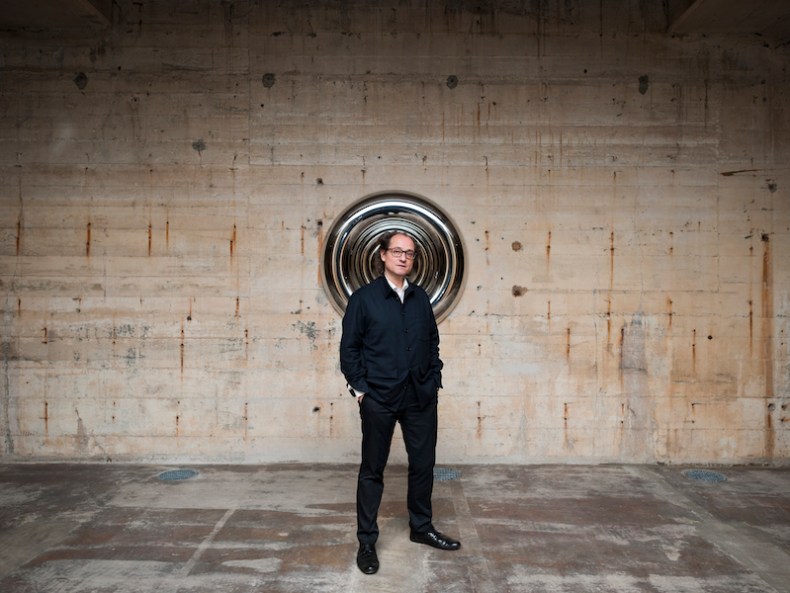
Désiré Feuerle photographed at his museum in Berlin beside Anish Kapoor’s Torus (2002). Photo: def image; © The Feuerle Collection
I meet Feuerle in the bright white back office of the museum, which is housed in a Second World War concrete telecommunications bunker. I am drinking green tea with director Daniele Maruca when he arrives with his Catalan wife Sara Puig, apologising profusely for being late and peeling off a black leather jacket. He has just flown to Berlin, and is about to fly off again the following day. When he discovers that I have not yet seen the collection, his delight is self-evident – his eyes light up and he jumps to his feet although he has only just sat down: ‘Let’s go,’ he says, as he searches for his keys, and I follow him along corridors and down stairs.
Feuerle explains that visitors are asked politely to relinquish their mobile phone and cameras before being ushered into the subterranean Sound Room. Totally disorientated in the pitch darkness, I stand and listen to the tones and equally resonant silences of John Cage’s Music for Piano No. 20, my eyes gradually adjusting to the rectangle of light that marks the room’s exit. These two and a half minutes are sufficient to cleanse the mind and heighten the senses in anticipation of what follows. Even though we are here alone the unnaturally silent and cavernous space prompts Feuerle to speak in hushed tones. I can see why: ahead of us in the imposing colonnade is a breathtaking sequence of Khmer stone sculptures that emerge out of the Stygian gloom, isolated in pools of light. The first of these pieces, a small serene head of a young male divinity just 11cm high, is set inside a glass vitrine and seems to float in space. Beyond it are more 11th-century figures from the Baphuon temple at Angkor – large and all but complete figures of Vishnu and Shiva, and voluptuous female divinities. The eye is constantly drawn in different directions, from the early Chinese stone furniture to the right, to the additional Khmer sculptures in stone and bronze to the left.
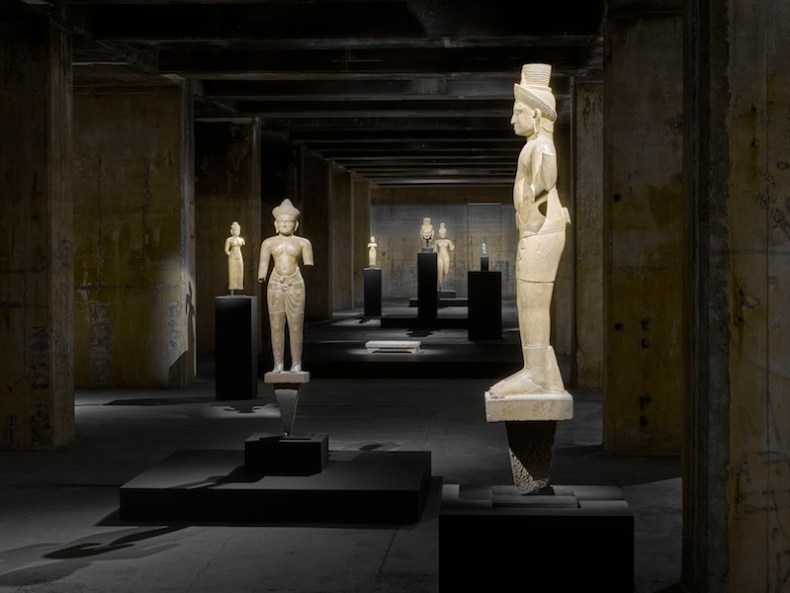
Khmer sculpture from the 7th–13 century, installation view, Feuerle Collection, Berlin. Photo: def image; © The Feuerle Collection
Apparently the bunker was never used during the war, so there are few lingering ghosts. Nature, however, has clearly left its mark on the building, with leaking water and damp artfully streaking and mottling its walls, floors and ceilings. Odd as it may sound, this brutalist industrial building is a work of art in its own right – or at least it has become one following the subtle, sensitive interventions of the minimalist architect John Pawson, who worked closely with Feuerle to enhance the peculiar qualities of the structure while adapting it to its new use. Feuerle has endlessly honed the selection of works on show, paying particular attention to their placement and accompanying lighting. The result is, as he says himself, a Gesamtkunstwerk – a total artwork. Without smartphones or cameras, or any distracting labels (guides hover to whisper answers to any questions), visitors must look only with their eyes.
Feuerle leads me to the building’s least expected feature: water. The Lake Room, prompted by the accidental flooding of the nearby Landwehr Canal, is viewed through a near invisible glass wall. The presence of the water within is almost as elusive, revealing itself in an occasional gentle ripple spreading across the mirrored surface. Out of the water more columns emerge, bringing to mind the Cisterns in Istanbul, but here the water provides a sustainable energy supply via a geothermal heat pump. It has an elemental grandeur and is completely mesmerising. ‘I have seen visitors who only ever look at the lake, or keep returning to it. Others say the building is like a monumental Donald Judd sculpture. I like that too,’ Feuerle tells me.
Feuerle has dreamed of creating a museum since the age of 25, although the germ of the idea was formed through the art postcards that he began to collect at 17. ‘I had the world of art in postcards on the floor – hundreds, no, thousands of them. All were works that I admired, anything from a Mondrian, a piece of porcelain or a pigeon-blood ruby, to pieces by Rothko and Beuys. I would arrange them in groups according to the feeling they gave me, and then pin them onto the walls for weeks to check if that feeling remained. I would then see if it still worked if I added a piece of contemporary art.’
As a gallerist in Cologne in the 1990s, he pioneered the juxtaposition of contemporary art with both antiquities and decorative arts, staging shows of, say, Anish Kapoor with Ban Chiang terracottas, or Richard Deacon with silver tea and coffee pots. It was – and remains – important to him to install old works of art in a contemporary way. ‘You have to remember that all pieces were contemporary once. I make no distinction between the old and the new – what matters to me is quality. The spirit of a work of art is never lost, and that interests me. The person who created it is still present even hundreds or thousands of years later. That person created something immortal. That is beautiful, and that touches me.’
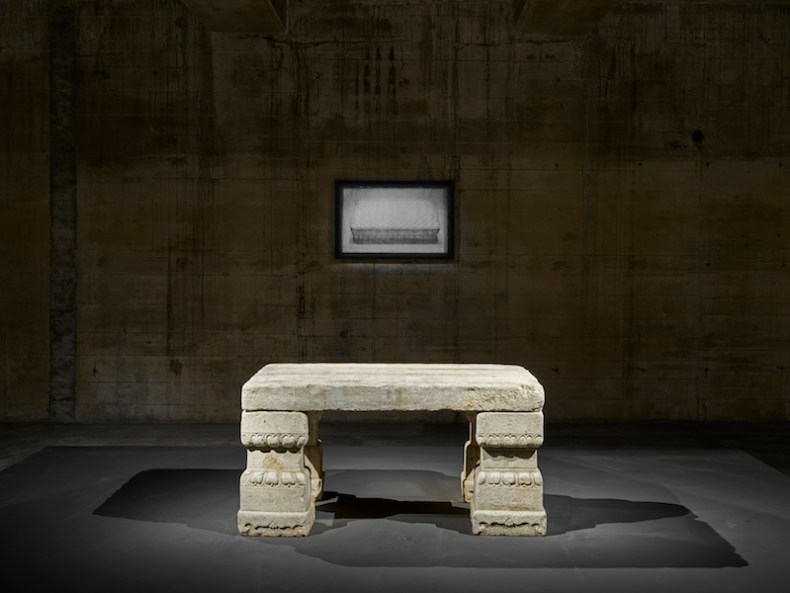
A 2010 daguerreotype by Adam Fuss hangs above a Chinese imperial stone table from the early Qing dynasty (17th century), installation view, Feuerle Collection, Berlin. Photo: def image; © The Feuerle Collection
Aside from staging these exhibitions, Feuerle was also discreetly collecting Asian art. ‘I wanted to create what was for me a very important collection, and do what I had done with postcards with real works of art.’ When he realised about a decade ago that the moment was right to make his project public, it was simply a case of finding the right building. ‘Berlin was appealing because I like very refined, elegant things and this is a rough city and I thought the contrast would be interesting.’ He continues: ‘It was very important to me to do everything myself. You have to feel the space and respect the pieces that you want to use by giving them sufficient space to be at peace. It is a very personal thing. Every piece has something that I want to bring out.’
He talks of a sculpture dominating a space and yet not detracting from the architecture or the lake. Rhythms between works emerge from the juxtapositions of the male and female figures, by variations in scale, and by the different intensities of light directed on each work that engage the eye or emphasise its meditative quality. ‘You have to feel what is right for each piece and yet ensure that everything works as a whole. The most important thing when you make an installation in a big space is to attract and refresh the eye because the eye gets tired.’ There is an element of choreography to all this: perhaps it is no coincidence that the Cage piece was made for Merce Cunningham, or that it was composed with the aid of the I Ching.
My eye is drawn to the brightest light of all, which illuminates the centrepiece in the main progression of Khmer sculpture. It is a low seating platform made in the Han dynasty as early as 200 BC. This is the beginning of Chinese furniture, Feuerle tells me, and this sculpture is the earliest known complete example (a double version is also known, housed in the Palace Museum in Beijing). Intriguingly, its underside is carved with ideograms representing the constellations of the night skies and of the seas, suggesting that it may have been made for someone thought to have dominion over both. Although the work has been exhibited elsewhere with a mirror underneath so as to reveal the ideograms, Feuerle chose to keep them hidden, maintaining the idea of concealed power.
The sensibilities of the art of China and Southeast Asia could not be more disparate, Feuerle tells me: ‘Khmer art is very sensual. To me, Chinese art is all to do with the head and Southeast Asian sculpture is about the gut. It is emotional, visceral. I am interested in both. I really enjoy entering other worlds, but I always focus on particular things within them.’ He describes his first encounter with a piece of Khmer sculpture when he was 17: ‘It made a huge impact. I thought it was so beautiful, and I kept it in my head. When I was 20 and lived in New York, I would go to the Met to look at Khmer pieces, and to MoMA to look at contemporary art. I would concentrate on one or two pieces, and then I would leave and go to Central Park and digest what I had seen. This was a kind of personal education, and I would do this every weekend.’
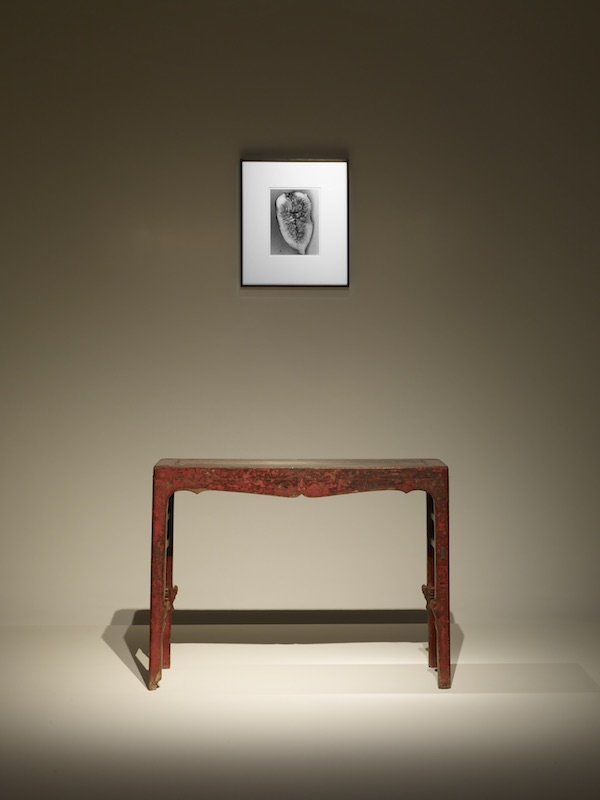
Nobuyoshi Araki’s Erotos (1993/2015) hangs above a Ming dynasty (16th century) red lacquered lute table, installation view, Feuerle Collection, Berlin. Photo: Nic Tenwiggenhorn/VG Bild-Kunst, Bonn; © The Feuerle Collection
His discovery of early Chinese stone furniture was somewhat different. ‘I was shown something and thought it interesting, but I realised that there had to be better examples than this, and so I looked for them. I also realised it offered an opportunity. Nobody else was interested in stone. Everyone only talked about huanghuali [a type of rosewood] and said it was the best, but the best was always lacquer’ (Feuerle has made a judicious collection of that too). ‘For me Chinese furniture is sculpture, a formal thing, and yet it is curious how I have always been able to feel that a piece is special even if I do not understand why at the time. I think I must have a natural intuition for quality, and maybe an eye which sees the essence of something,’ he tells me. He walks across to a Qing dynasty white marble rectangular table. ‘When I asked scholars from the Palace Museum in Beijing to research this, they were astonished and told me that it was the table at which the emperor would take tea with his mother on his birthday – they showed me a print in the archive. It was presumed to have been destroyed.’ He is still incredulous, but the history of a piece, he insists, is just an extra.
This is one of four Chinese stone tables that makes for another striking display of objects; it is only as I begin to look carefully at them that I decipher the images hanging above. Over the imperial table, for instance, is one of Adam Fuss’s large daguerreotypes on siler, a haunting image of a mattress. ‘Chinese furniture for me has a sort of erotic appeal, and so I wanted to show it with works of art that give me the same feeling,’ Feuerle says. Most of the furniture is juxtaposed with the more explicitly erotic black and white photographs by the Japanese artist Nobuyoshi Araki, in which naked or partially clad women are bound and strung up.
Upstairs in the museum the relationships between the exhibits are more specific. Above a rare, understated 16th-century red lacquered lute table is an Araki photograph of a curving open fig. Such a sensual fruit, Feuerle comments. There are echoes of it in the root-form orifice of the nearby Cristina Iglesias bronze, pietra serena, and water ‘well’ that Feuerle commissioned for the collection: in fact, there is a great deal here that might be described as L’Origine du monde.
Less explicit are works such as the 17th-century Ming ‘eight posts’ canopy bed standing opposite, whose delicate traceries make it an unusually fragile example. Some Chinese scholars believe it might have been made for a concubine. The extraordinary early Qing red lacquer Imperial chair elaborately carved with mushrooms was made as a gift for the emperor and housed in his bedroom – its pair is in the Palace Museum in Beijing.
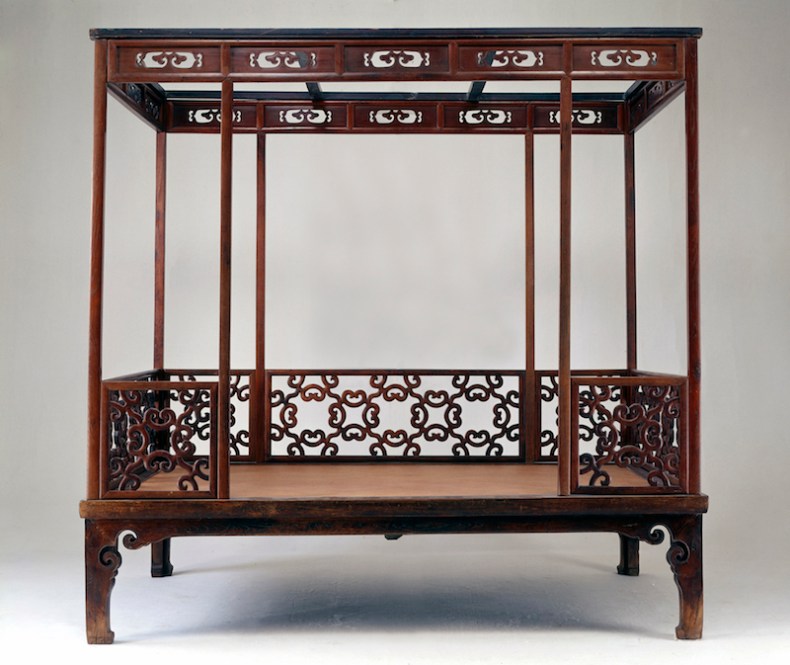
Eight posts canopy bed, China, Ming dynasty (17th century). Feuerle Collection, Berlin
Close by are a pair of 16th-century Imperial black lacquered bookcases richly decorated with five-fingered golden dragons: another important gift, this time for the Ming emperor’s study. At some distance between them hangs one of Fuss’s unique and meditative photograms of smoke. ‘They look beautiful together,’ Feuerle admits. ‘Each enriches the other.’ James Lee Byars, an artist for whom death, perfection, and eroticism was important, also features here.
Of course all of this would be mere showmanship if it weren’t for the intrinsic and often breathtaking quality of each of these pieces. ‘It was not easy, and it took a lot of work to find them,’ Feuerle explains. After closing his Cologne gallery in 1998 (he still acts as a curator and consultant), he moved permanently to Asia and still spends around seven months of the year travelling there. He likes to collect interesting people too, he says, and prefers to make his acquisitions from the collectors he encounters. ‘You also need a bit of luck in life to meet the right people,’ he continues. ‘This is part of the process of learning. You grow with them, and through them meet other good people.’
Of his collection of Chinese scholar’s objects, Feuerle presents just two pieces – perhaps the most sophisticated and refined objects here and potentially the easiest to overlook. These are two small 17th- or 18th-century cups carved out of incense wood, the most precious of all materials at the time. These tactile little cups, carved with scholar’s rock and flower motifs and lined with gold, would simply be held and their fragrance savoured. Downstairs, meanwhile, the Incense Room is under construction behind mirrored glass walls.
Feuerle has been honoured many times by invitations to incense ceremonies in China and Taiwan. A tradition dating back more than 1,000 years, incense ‘tasting’ may be considered akin to poetry and philosophy. ‘It fascinated me so much that I thought we should bring this sensual, and at the same time, meditative and spiritual ceremony into our museum,’ he tells me. As the traditional ceremony of burning incense wood to make the oil takes over two hours, an electric incense table was developed with the help of a Taiwanese master and made to a minimalist design by John Pawson that respected traditional Chinese forms and construction. It is a testament to Feuerle’s perfectionism and eye for detail that two tons of African Blackwood was ordered so as to select the finest available. Engineering and design took a year to complete, and the table’s construction nine months. Scheduled to open in the middle of 2017, the room will add a further sensory dimension to this singular museum.
From the February issue of Apollo: preview and subscribe here
Unlimited access from just $16 every 3 months
Subscribe to get unlimited and exclusive access to the top art stories, interviews and exhibition reviews.

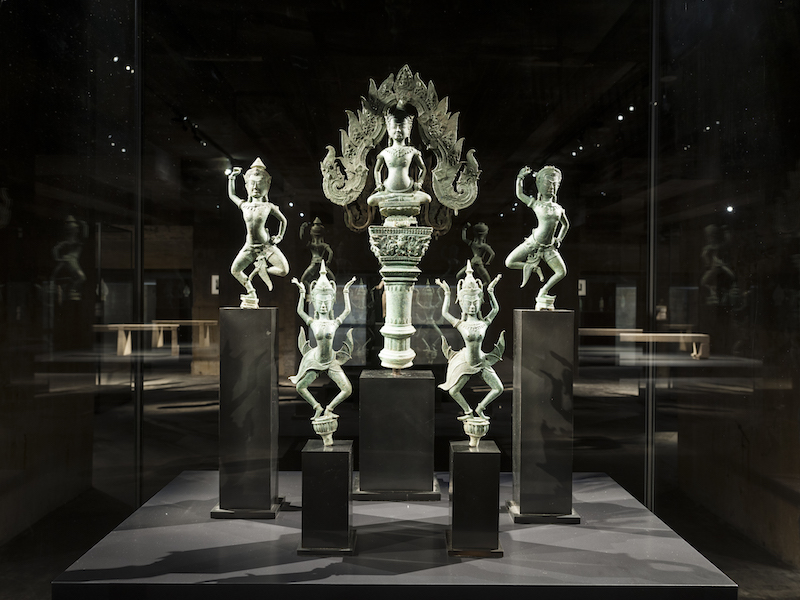
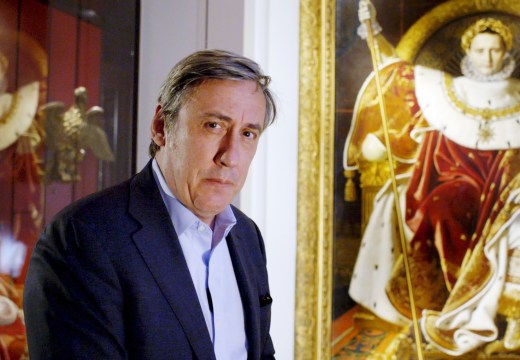
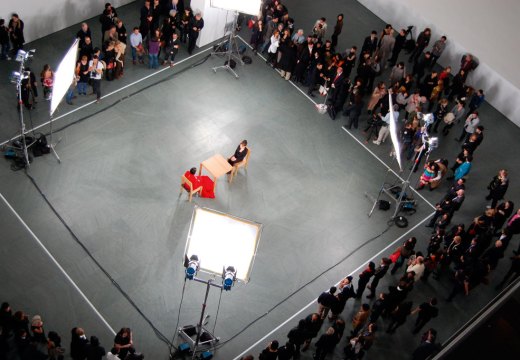










![Masterpiece [Re]discovery 2022. Photo: Ben Fisher Photography, courtesy of Masterpiece London](http://www.apollo-magazine.com/wp-content/uploads/2022/07/MPL2022_4263.jpg)
It’s time for the government of London to return to its rightful home